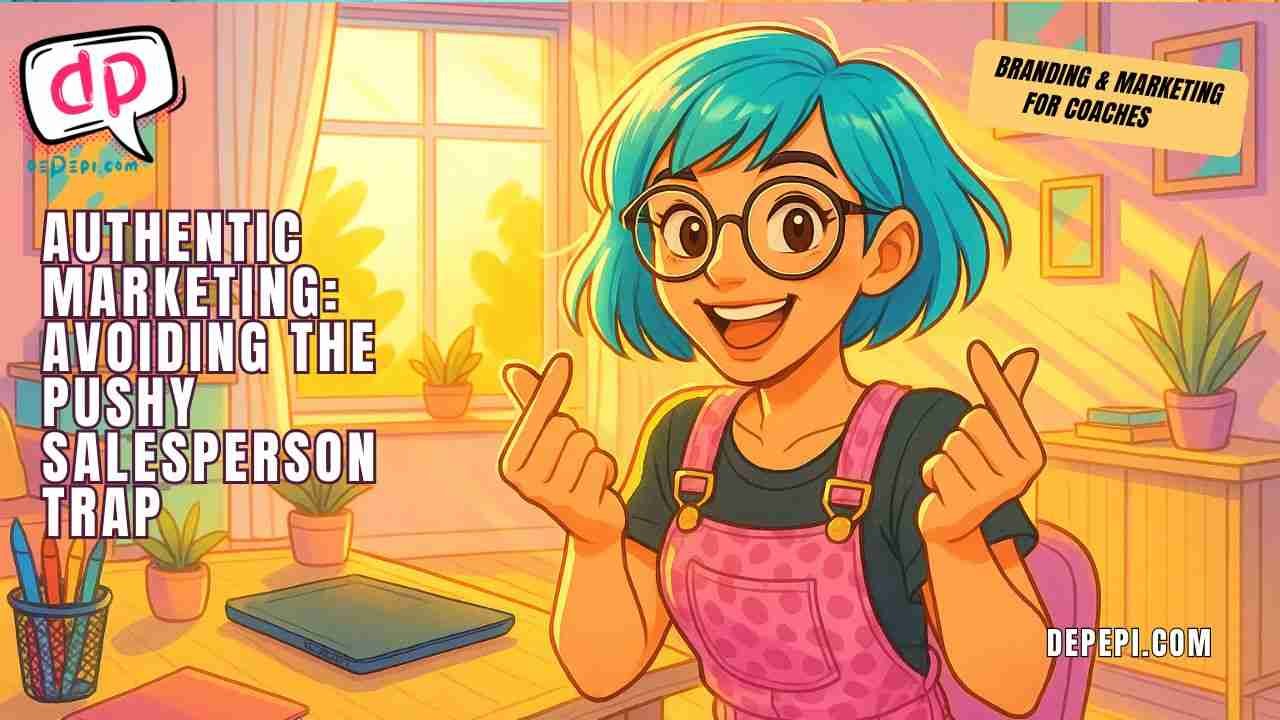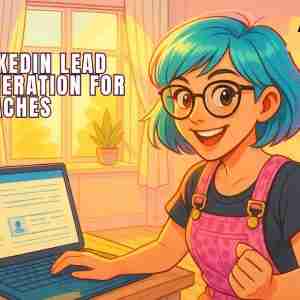Authentic Marketing: Avoiding the Pushy Salesperson Trap

Authentic marketing for coaches isn’t about aggressive pitches but about connection, credibility, and genuinely serving your audience. Too many coaches fall into the trap of feeling like a salesperson (sending endless messages, pressure-selling) or relying on tactics that undermine trust. Authentic marketing starts with finding your voice, builds on real results and testimonials, and evolves as your business grows.
Unlike one‑size‑fits‑all sales funnels, a coach’s buyer journey often requires multiple engagements before someone is ready to work with you. Your goal isn’t just to sell but to guide, nurture, and genuinely resonate.
Why Coach Marketing Often Feels “Salesy”
Many coaches default to reactive, high-intensity marketing: DMs on LinkedIn, sales-heavy posts, or sporadic outreach when revenue is low. This reactive cycle, market only when you need clients, leads to burnout and poor results.
Other common missteps
Treating marketing like a disconnected set of tactics rather than a cohesive journey.
Rushing prospects before they’re ready, leading to friction and mistrust.
Struggling to differentiate in a crowded space, without authenticity, stories feel hollow.
In the coaching space, clients invest not just in services but in transformation and trust. When your marketing feels transactional, prospects either ignore or recoil.
Coaches who lean too hard on bold claims, rush urgency, or oversell risk damaging reputation—especially with audiences who value thoughtful, consultative connection.
Principle: Authentic, Relationship-First Marketing
Find and Use Your Voice
Authentic marketing starts with clarity about why you coach and who you serve. When your content is rooted in your purpose and real client needs, you attract aligned folks who resonate emotionally—no persuasion required.
Consistency Over Volume
Marketing isn’t about hitting your audience only in client-need crises, but about showing up consistently.
“Marketing isn’t about finding clients directly… it’s about all the touchpoints that come before someone’s ready to work with you. These activities should happen consistently.”
Daily micro-content, regular email sequences that educate, and real conversations are far more sustainable than reactive bursts.
Relationship-focused Messaging
Rather than pitching incessantly, focus on providing value: thought-provoking questions, insights, and content that speaks to pain points. Effective outreach centers on understanding prospects and helping them feel heard, rather than being sold to.
Social Proof: Credibility Through Results and Testimonials
Social proof bridges the credibility gap. Success stories, even short testimonials, help prospects see real humans achieving real change through your coaching.
Particularly powerful are stories of clients who mirror your ideal audience, since potential clients then see themselves in the transformation.
Collecting Powerful Testimonials
How to make social proof resonate:
Ask for detailed, specific testimonials: what was the challenge, your process, the result? Avoid vague praise like “awesome service.”
Include real names, photos (with permission), and context (this adds depth and authenticity).
Obtain permission through a structured process: integrate testimonial collection into your client wrap-up system to keep stories up to date.
Strategic Placement
Place social proof where prospects experience hesitation. For example:
Near program pricing or value pages.
Before or after describing the program structure.
In email follow-ups after the post-discovery call.
Case Studies for Deeper Resonance
Well-crafted case studies (mini-stories that include challenge, approach, outcomes, quotes, and sometimes metrics) work as “testimonials on steroids” and can dramatically influence conversions.
Multi‑channel social proof
Repurpose testimonials and case studies. For example:
Snackable quotes for social posts or visual carousels
Blog story formats
Newsletter highlights
Landing page inserts
Common Pitfalls & Better Alternatives
Pushy Tactics to Avoid
According to behavioral and sales analysis, these tactics often degrade trust:
Repeated unsolicited calls or messages
Faux urgency or fear-based scarcity
Overselling or making unrealistic promises
Classic sales funnels that pressure prospects to act before they’re ready often backfire, and they may alienate the audience you want to serve with integrity.
Consultative, Empathetic Outreach
Instead, adopt a consultative, empathetic approach:
Pre-qualify prospects thoughtfully (are they aligned with your work?) Follow these tips here.
Aim to understand their pain and timeline before extending an invitation.
Position yourself as a helpful guide, not a soldier pushing quotas.
Pleasant Persistence Over Aggression
Persistence is okay; aggression is not. One recommendation: research before reaching out, personalize your engagement, then respect boundaries and objections. Use pauses effectively rather than rushing to fill silence or close prematurely.
Why Funnels & Aggression Often Hurt Coaches Who Value Authenticity
Many marketing experts advocate for hyper-segmented funnels and high-pressure opt-ins, as well as limited-time offers. But for coaches whose value depends on relationships, these strategies can feel misaligned, manipulative, or inauthentic.
Controversial
“Classic sales funnels and aggressive outreach often backfire, damaging reputation and stunting growth for coaches who value authenticity.”
Why?
It creates dissonance between the message and the method. If you’re promising vulnerability and support, yet rushing prospects, there’s a disconnect.
Prospects may step away, feeling misled or undervalued.
Referral growth suffers because clients don’t recommend experiences that felt transactional.
Instead, a slower, values-aligned approach may convert slightly more slowly but retains long-term trust, referrals, and sustainability.
IN Short
Marketing evolves as your coaching business matures: start simple, scale thoughtfully.
Building credibility and social proof early is essential; highlight client transformations with specificity, including photos and trauma-free processes.
Authentic communication converts more effectively than aggressive tactics: prospects engage with real value, not bold claims.
Aggressive funnels can undermine credibility: they may yield short-term leads but cost long-term trust.
Relationship-first outreach builds sustainable pipelines through consultative, personalized engagement, gentle nurturing, and respectful persistence.
Checklist
| What | How |
|---|---|
| Voice & Messaging | Clarify your coaching purpose and define your ideal client avatar. Share a personal story. |
| Content Cadence | Commit to daily/weekly touchpoints on one or two primary platforms. |
| Social Proof | Collect testimonials and case studies regularly; update every 6–12 months. |
| Funnel Design | Build value-first sequences (e.g., lead magnet → nurturing → invitation). |
| Outreach | Research each prospect, ask consultative questions, and avoid pressure. |
| Metrics & Adjustment | Track engagement, lead progression, conversion rates; iterate. |
NEED HELP?
Want to learn how to focus on:
consistent, purpose-driven messaging,
social proof that tells real, nuanced stories,
consultative outreach,
and avoiding aggressive pressure tactics?
Join Branding and Marketing for Coaches (Life, Health, Wellness)





